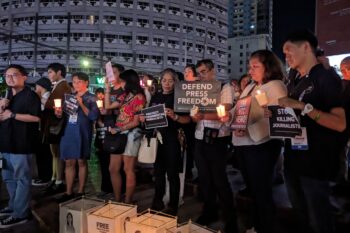DAVAO CITY (MindaNews / 23 Nov) – Cacao is a good investment compared to other high value crops, according to a farmer in Baguio District in this city.
At the three-day Kakao Konek forum for those involved in the cacao industry held at the Apo View Hotel here, Johhny Silva, owner of Silva Cacao Industry, said he has earned better since he started a cacao farm.
Coming from a daily of wage P250 as a worker at a pineapple plantation, he now earns at least P300,000 from his current stock of 50,000 cacao seedlings, which takes him five to six months to produce.
He cited that for each seedling sold at P18, production cost is at P10 or P12, gaining at least P6 profit.
Silva’s half hectare of land in Purok 3, Cadalian, Baguio District, was awarded to him through the Comprehensive Agrarian Reform Program in 2007.
The farm had some 500 old cacao trees in Brazilian or Celebes varieties. With a grant from the Sustainable Cocoa Enterprise Solutions for Smallholders (SUCCESS) Alliance Philippines: Phase II, Silva became a farmer field school student.
The SUCCESS Alliance receives funding from United States Department of Agriculture and US Agency for International Development and is being implemented by a US nonprofit development organization, Agricultural Cooperative Development International / Volunteers in Overseas Cooperative Assistance (ACDI/VOCA).
Silva rehabilitated his farm by side grafting the old trees with UF18 variety. The old variety of cacao produced 200-300 kilos of dried beans per hectare a year, while the new varieties can annually yield up to two tons of dried beans per hectare.
In 2008, he won a national award for most outstanding farmer and was granted post-harvest facilities, specifically village-type solar drier and fermentation box for cacao.
The village type solar drier has a capacity of 500 kilos of cacao beans per batch, and fermentation box has 1,000 kilos of cacao beans per batch.
However, Silva said he has not fully maximized his post harvest facilities since he began producing cacao germinated seeds for the supply of some 30 nursery operators in Luzon, Visayas and Mindanao.
He decided to produce germinated seeds instead of dried cacao beans to help in achieving the vision of the cacao industry and the government to provide seven million seedlings a year until 2017.
More cacao trees should be planted in line with the 2020 goal of the Philippines’ industry players to supply 100,000 metric tons of dried cacao beans per year for the world market, he added.
Income is also higher with germinated cacao seeds than dried beans.
He explained that three kilos of wet cacao seeds can only make a kilo of dried beans sold at P85, but similar amount of wet seeds can make two kilos of germinated seeds sold at P110 a kilo.
Silva has almost completed a contract to supply 1.5 million cacao seeds sold at 4 centavos per seed to the Catholic Relief Services.
He cited that next year, he will be supplying a total of one million seedlings to a private firm here, and at least 200,000 cacao seedlings to the Department of Environment and Natural Resources.
Pedro V. Cruz, manager of Mars Cocoa Development Center that provides training for farmers here, said cacao is a good investment because it is the only source for chocolate.
“The demand is high and the supply is low. Cacao gains two to three times more income than coconut,” he added.
On the other hand, Pedro Arnado, chairperson of Kilusang Magbubukid ng Pilipinas, Southern Mindanao, said farmers are only excited about the price of dried cacao beans while it is high.
But, he warned that if the price will go down, cacao farmers might suffer from high cost of pesticides as the government cannot support the sector’s needs.
“There is no problem had the Philippine government supported the industry. There is a cacao industry and plantation in Davao del Sur but the small farmers are left being controlled,” he said. (Lorie Ann A. Cascaro / MindaNews)
